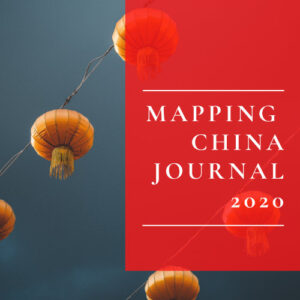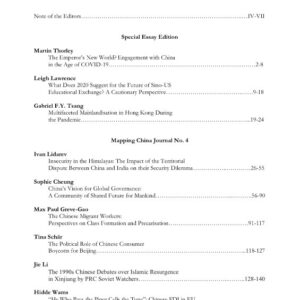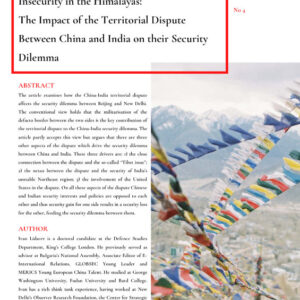MAPPING CHINA JOURNAL NO. 4



CONTENT — SPECIAL ESSAY EDITION
ClCK HERE TO DOWNLOAD THE SINGLE ARTICLE
This piece considers post-pandemic expert analysis of contemporary China. It argues that the CCP has achieved a high degree of “decontestation” in the domestic arena given its considerable power over organs by which to frame citizens’ perceptions of reality. COVID-19 has emphasised this feature, marking a strong contrast between independent scrutiny of government decisions elsewhere, and continued ambiguity around the party-state’s initial response and the utilisation of vast resources to frame the pandemic for its domestic audience. Foreign organisations and individuals that engage the party-state without “China literacy” risk becoming unwitting performers in the CCP’s reality construction. At the same time, the consequences of the PRC’s domestic vicissitudes increasingly impact beyond its border. The essay argues that those working in fields related to contemporary China should carefully consider the role of elite domination and associated reality construction.
ClCK HERE TO DOWNLOAD THE SINGLE ARTICLE
This article discusses the recent deterioration of Sino-US relations through the lens of international education. Although the pandemic was a pressure point of declining relations, actions taken by both governments suggest that educational exchange, a key tool of soft power initiatives, has been weaponized and ‘hardened’ to achieve discursive narratives or favourable power dynamics.
From the vantage point of the year 2020, the author cautiously looks towards the future of Sino-US relations with the understanding that positive diplomacy begins and ends with education. As such, it should be a main policy priority for both nations.
ClCK HERE TO DOWNLOAD THE SINGLE ARTICLE
As a conscious director of mainlandising Hong Kong for internal security and economic outreach, the central government enigmatically manipulates the reciprocation of different classes regardless of certain constitutional constraints. The progress of mainlandisation was intensified during and after the increasingly radical anti-extradition bill protests in 2019, and did not cease during the pandemic. This article expounds that the outbreak of the coronavirus crisis and the crowd control hence enforced assisted the subterranean and opportunistic works of the Chinese government to pacify Hong Kong and promote patriotism. The Hong Kong government and pro-government locals, as stakeholders, also practically helped actualise the central wish for unification correspondingly.
CONTENT — MAPPING CHINA JOURNAL NO. 4
ClCK HERE TO DOWNLOAD THE SINGLE ARTICLE
The article examines how the China-India territorial dispute affects the security dilemma between Beijing and New Delhi. The conventional view holds that the militarisation of the defacto border between the two sides is the key contribution of the territorial dispute to the China-India security dilemma. The article partly accepts this view but argues that there are three other aspects of the dispute which drive the security dilemma between China and India. These three drivers are: 1) the close connection between the dispute and the so-called “Tibet issue”; 2) the nexus between the dispute and the security of India’s unstable Northeast region; 3) the involvement of the United States in the dispute. On all these aspects of the dispute Chinese and Indian security interests and policies are opposed to each other and thus security gain for one side results in a security loss for the other, feeding the security dilemma between them.
ClCK HERE TO DOWNLOAD THE SINGLE ARTICLE
This paper analyses the Chinese government’s new foreign policy slogan A Community of Shared Future for Mankind (CSFM) to discern how China presents and constructs the concept as a narrative to foreign audiences. It finds that Chinese authorities put forth three narratives through the CSFM vision: an international system narrative of global interdependence, an issue narrative of global governance failure, and an identity narrative of China as a responsible and capable leader. Together, they formulate the strategic narrative of an interconnected international system facing increasing global threats, demanding for immediate resolution. Through these narratives, Beijing positions itself as a responsible stakeholder within the current world order, working to improve the system and contribute to solving pressing global challenges. To understand and situate Beijing’s international strategic priorities, this paper employs discourse analysis to analyse speeches made by leading Chinese authorities from 2014 to 2019. It draws upon strategic narrative as a framework to decipher key themes and storylines within these speeches, all of which together serve as building blocks of the CSFM narrative.
ClCK HERE TO DOWNLOAD THE SINGLE ARTICLE
This article investigates how the compatibility of class and precarisation can be conceptualised in the case of Chinese migrant workers. While the debate often centres around their collective actions, this article will take a broader look by compiling social, political and economic developments that promoted the emergence of the Chinese migrant workers. Taking Thompson’s class concept as a theoretical point of departure, class is defined as a sociohistorical process. Katznelson’s critical enquiry adds to the theoretical framework, as he offers a comparatively open approach by proposing an analysis on different conceptual layers. It is further argued that precarisation accompanies the class formation process, affecting the layers of structure and ways of life while evoking responses on the layers of dispositions and collective action. Following these theoretical investigations, the class formation process of migrant workers is retraced, examining the layers of structure and ways of life, the role of precarisation, and the dispositions and collective action of migrant workers as well as differences between new and old generations of migrant workers. Finally, a framework combining the concepts of class formation and precarisation provides a new understanding of China’s contradictory transformation processes.
ClCK HERE TO DOWNLOAD THE SINGLE ARTICLE
This essay aims to discuss the political role of Chinese consumer boycotts for the government in Beijing. The French retail chain Carrefour witnessed the economic leverage of Chinese consumers in 2008 and will serve as an illustrative example. In the first part, it is shown how Chinese consumer boycotts are supportive for the Chinese government as they can lead to a gain of legitimacy. The part about risks then highlights how boycotts also can turn in a counter-productive threat. The essay concludes that to the extent that they remain under government control, Chinese consumer boycotts can be considered as supportive for the Chinese government, but also that they should not be underestimated – neither by foreign firms conducting business in China nor by Beijing.
ClCK HERE TO DOWNLOAD THE SINGLE ARTICLE
Following the collapse of the Soviet Union in 1991, China panicked and began to analyse the potential root causes. China, like the Soviet Union, is a multinational country with religious diversity. Chinese Soviet-watchers paid particular attention to the impact of the Islamic resurgence in the newly independent Central Asian republics on China’s Muslim populations in the Xinjiang Uyghur Autonomous Region. Those writings tended to define the Xinjiang minorities fighting for religious freedom as political dissents opposing socialism. They also perceived that after the Soviet collapse, international forces would move against China. Xinjiang was seen as the most vulnerable to foreign conspiracies, owing to this Islamic resurgence and Western influence. These viewpoints justified the agenda of the CCP after the Cold War, when the Party believed that Western countries had a master plan to undermine China.To summarise, the debates of Chinese Soviet-watchers emphasized the importance of the Chinese government to take a firm hand in combating Xinjiang’s Islamic resurgence. The strategies that arose from these debates may inform readers of China’s present state policies and actions.
ClCK HERE TO DOWNLOAD THE SINGLE ARTICLE
This essay examines Chinese investments into major container ports in the European Union (EU). These ports matter: the advent of containerisation has rapidly impacted the face of the modern world economy and has irreversibly globalised supply chain economics. In times of war, seaports play an essential strategic role as well. Therefore, seaports are understood as part of a state’s (or the EU’s) strategic or critical infrastructure, the disruption of which would have sizable implications. Currently, we see a development of Chinese companies, both private and state-owned, increasingly investing in the EU’s major seaports. This cannot be seen as an innocent type of investment. By gaining a stake in the EU’s critical infrastructure, China can bolster its political influence throughout the EU. These dynamics were described by an EU port lobbyist as ‘he who pays the piper calls the tune.’ This has to be understood within a context of changing EU-China relations, demonstrated by the European Commission naming China a ‘systemic rival promoting alternative models of governance’ in 2019. This essay argues that to protect European strategic autonomy, the EU needs to adopt robust policy measures to counter the increasing Chinese influence on the EU’s critical infrastructure.
